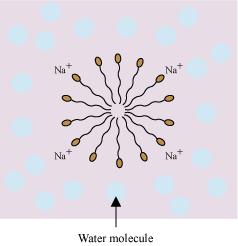 Short Answer Type
Short Answer Type(a) How can a colloidal solution and true solution of the same colour be distinguished from each other ?
(b) List four applications of adsorption.
Explain the following observations:
(a) Lyophilic colloids are more stable than lyophobic colloid.
(b) Coagulation takes place when sodium chloride solution is added to a colloidal solution of ferric hydroxide.
(c) Sky appears blue in colour.
(a) In which of the following does adsorption take place and why?
(i) Silica gel placed in the atmosphere saturated with water.
(ii) Anhydrous CaCl2 placed in the atmosphere saturated with water.
(b) How does BF3 act as a catalyst in industrial process?
(c) Give an example of shape selective catalysis.
When soap molecule are present in water the molecules arrange themselves in the form of cluster in such a manner that their hydrophobic ends are away from the water molecules and their hydrophillic or ionic end are towards the water molecules.
This is known as micelle formation and the cluster that is formed is called as micelle.
micelle system behaves as a true solution in low concentration and as colloidal solution as high concentration.

 Long Answer Type
Long Answer Type(a) Of NH3 and CO2 which will be adsorbed more readily on the surface of charcoal and why?
(b) How are multimolecular colloids different from macro-molecular colloids?
(c) State the principle of electro-dialysis.
